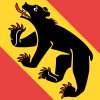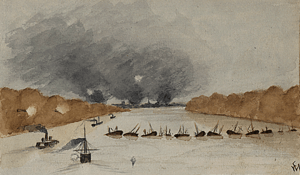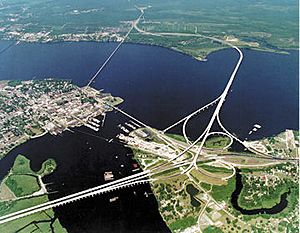New Bern, North Carolina facts for kids
Quick facts for kids
New Bern, North Carolina
|
|||
|---|---|---|---|

Main façade of the New Bern City Hall
|
|||
|
|||
| Nickname(s):
The Birthplace of Pepsi
|
|||
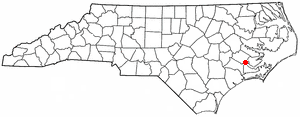
Location in Craven County and the state of North Carolina
|
|||
| Country | |||
| State | |||
| County | Craven | ||
| Founded | October 1710 | ||
| Chartered | November 23, 1723 | ||
| Founded by | Baron of Bernberg | ||
| Named for | Bern, Switzerland | ||
| Area | |||
| • Total | 29.95 sq mi (77.56 km2) | ||
| • Land | 28.46 sq mi (73.70 km2) | ||
| • Water | 1.49 sq mi (3.86 km2) | ||
| Elevation | 13 ft (4 m) | ||
| Population
(2020)
|
|||
| • Total | 31,291 | ||
| • Density | 1,099.59/sq mi (424.56/km2) | ||
| Time zone | UTC-5 (Eastern (EST)) | ||
| • Summer (DST) | UTC-4 (EDT) | ||
| ZIP codes |
28560, 28562
|
||
| Area code(s) | 252 | ||
| FIPS code | 37-46340 | ||
| GNIS feature ID | 2404358 | ||
New Bern is a city in Craven County, North Carolina, United States. It is also the county seat, which means it's where the local government is located. In 2020, about 31,291 people lived there.
The city is special because it sits where the Neuse and Trent rivers meet. This spot is close to Pamlico Sound on the North Carolina coast. New Bern is about 112 miles east of Raleigh, the state capital.
New Bern was started in October 1710 by people from Germany and Switzerland. Their leader was Christoph von Graffenried. They named the new town after Bern, a region in Switzerland where many of them came from. New Bern is the second-oldest European town in North Carolina, after Bath.
From 1770 to 1792, New Bern was the capital of North Carolina. After the American Revolution (1775–1783), the city became very successful. It was known for its rich cultural life and was even called "the Athens of the South." Its Masonic Temple and Athens Theater are still active today.
New Bern has four historic areas listed on the National Register of Historic Places. These areas have many old homes, stores, and churches from the early 1700s. You can walk from the waterfront to see over 164 historic buildings. The city is also known for its 2,000 crape myrtles, which are its official flower.
Contents
New Bern's Past: A Look at History
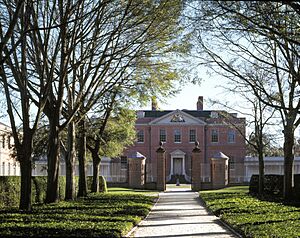
New Bern was founded in October 1710 by people from Germany and Switzerland. Their leader, Christoph von Graffenried, named the town after his home region, Canton of Bern. The original town plan was shaped like a cross.
The British governor's palace, now called Tryon Palace, was the capital of North Carolina from 1770 to 1792. A fire damaged the capitol, and the state government moved to Raleigh. Tryon Palace was the first permanent capital building in North Carolina.
North Carolina did not have a printer until 1749. The state hired James Davis from Virginia to be their official printer. He settled in New Bern and became North Carolina's first postmaster. Davis also started the North-Carolina Gazette, the first newspaper in North Carolina.
Growth and Change in the 1800s
In the 1800s, New Bern became the largest city in North Carolina. It grew rich from trading goods, including those from large farms. After Raleigh became the state capital in 1792, New Bern focused on trade by shipping goods to the Caribbean and New England. The city's population reached 3,600 by 1815.
During the American Civil War (1861-1865), New Bern was the site of the Battle of New Bern in 1862. Union forces took control of the town and stayed there until the war ended in 1865. Many enslaved people in the area found freedom by going to Union Army camps. The Union Army set up the Trent River camp in New Bern to help these refugees. Missionaries taught adults and children how to read and write.
Because the Union Army stayed in New Bern, the city avoided some of the war's destruction. However, the population grew a lot due to the many freed people who came there. In 1860, New Bern had 5,432 people, with 57% being Black. By the end of the war, the population was over 20,000.
New Bern recovered faster than many other cities after the war. By the 1870s, the lumber industry became very important to New Bern's economy. The city continued to be a center for freed people, who built their own churches, groups, and businesses. By 1877, most of the city's population was Black.
In the late 1800s, laws were passed that made it harder for Black citizens to vote. This meant they could not take part in politics or hold local offices. This situation continued until new federal laws were passed in the 1960s.
By 1890, New Bern was the biggest lumber center in North Carolina. There were as many as 16 lumber mills, employing hundreds of people. This lumber boom lasted until the 1920s. Many beautiful homes were built in New Bern during this time, and some are still standing. Today, only Weyerhaeuser still makes lumber in the area.
New Bern has four National Historic Districts and two local ones. These help protect the city's old buildings. Union Point Park is a beautiful area where the Neuse and Trent rivers meet.
Hurricanes and Their Impact
New Bern is close to the Atlantic coast, so it can be affected by Atlantic hurricane seasons. In the 1700s, a big hurricane in 1769 caused a lot of damage. Other hurricanes like Hurricane Ione in 1955 and Hurricane Floyd in 1999 also caused major flooding.
In September 2018, Hurricane Florence hit the United States near New Bern. A storm surge of up to 13.5 feet, plus days of heavy rain, caused severe flooding in many parts of the town.
Exploring New Bern's Geography
New Bern is located where the Trent and Neuse rivers meet. These are tidal rivers in North Carolina's Inner Banks region.
The city covers about 29.95 square miles (77.56 square kilometers). Most of this area is land, with about 1.49 square miles (3.86 square kilometers) being water.
U.S. Route 17 and U.S. Route 70 pass through New Bern. These roads help people travel to other cities. US 70 goes west to Kinston and southeast to Morehead City near the ocean. Raleigh, the state capital, is about 112 miles west on US 70. US 17 goes southwest to Jacksonville and north to Washington.
New Bern's Climate
New Bern has a humid subtropical climate. This means summers are hot and humid, with many afternoon thunderstorms. Spring and fall are usually mild. Fall colors appear from late October to early November. Winters are mild and drier, with very little snowfall.
| Climate data for New Bern, North Carolina (Coastal Carolina Regional Airport), 1991–2020 normals, extremes 1948–present | |||||||||||||
|---|---|---|---|---|---|---|---|---|---|---|---|---|---|
| Month | Jan | Feb | Mar | Apr | May | Jun | Jul | Aug | Sep | Oct | Nov | Dec | Year |
| Record high °F (°C) | 82 (28) |
88 (31) |
92 (33) |
95 (35) |
100 (38) |
105 (41) |
106 (41) |
103 (39) |
101 (38) |
97 (36) |
87 (31) |
83 (28) |
106 (41) |
| Mean maximum °F (°C) | 75.1 (23.9) |
77.0 (25.0) |
82.5 (28.1) |
87.3 (30.7) |
92.0 (33.3) |
95.8 (35.4) |
96.7 (35.9) |
95.8 (35.4) |
91.8 (33.2) |
86.9 (30.5) |
80.6 (27.0) |
75.6 (24.2) |
97.8 (36.6) |
| Mean daily maximum °F (°C) | 55.1 (12.8) |
58.5 (14.7) |
64.9 (18.3) |
73.6 (23.1) |
80.4 (26.9) |
86.7 (30.4) |
89.6 (32.0) |
87.9 (31.1) |
83.1 (28.4) |
74.9 (23.8) |
65.6 (18.7) |
58.5 (14.7) |
73.2 (22.9) |
| Daily mean °F (°C) | 44.5 (6.9) |
47.1 (8.4) |
53.2 (11.8) |
61.8 (16.6) |
69.5 (20.8) |
77.0 (25.0) |
80.4 (26.9) |
78.9 (26.1) |
74.2 (23.4) |
64.2 (17.9) |
54.2 (12.3) |
47.7 (8.7) |
62.7 (17.1) |
| Mean daily minimum °F (°C) | 33.8 (1.0) |
35.8 (2.1) |
41.5 (5.3) |
49.9 (9.9) |
58.7 (14.8) |
67.2 (19.6) |
71.2 (21.8) |
70.0 (21.1) |
65.2 (18.4) |
53.5 (11.9) |
42.8 (6.0) |
36.9 (2.7) |
52.2 (11.2) |
| Mean minimum °F (°C) | 17.6 (−8.0) |
21.5 (−5.8) |
25.9 (−3.4) |
35.2 (1.8) |
46.1 (7.8) |
56.5 (13.6) |
63.6 (17.6) |
62.8 (17.1) |
54.4 (12.4) |
38.0 (3.3) |
27.7 (−2.4) |
22.5 (−5.3) |
16.1 (−8.8) |
| Record low °F (°C) | 1 (−17) |
6 (−14) |
16 (−9) |
29 (−2) |
32 (0) |
44 (7) |
55 (13) |
50 (10) |
43 (6) |
26 (−3) |
17 (−8) |
−4 (−20) |
−4 (−20) |
| Average precipitation inches (mm) | 3.89 (99) |
3.32 (84) |
3.85 (98) |
3.18 (81) |
4.25 (108) |
4.60 (117) |
6.26 (159) |
6.81 (173) |
6.33 (161) |
3.56 (90) |
3.33 (85) |
3.63 (92) |
53.01 (1,346) |
| Average snowfall inches (cm) | 0.3 (0.76) |
0.3 (0.76) |
0.0 (0.0) |
0.1 (0.25) |
0.0 (0.0) |
0.0 (0.0) |
0.0 (0.0) |
0.0 (0.0) |
0.0 (0.0) |
0.0 (0.0) |
0.0 (0.0) |
0.9 (2.3) |
1.5 (3.8) |
| Average precipitation days (≥ 0.01 in) | 10.2 | 9.6 | 10.0 | 8.9 | 10.6 | 11.5 | 13.6 | 13.6 | 11.1 | 8.8 | 8.3 | 10.8 | 127.0 |
| Average snowy days (≥ 0.1 in) | 0.1 | 0.1 | 0.0 | 0.1 | 0.0 | 0.0 | 0.0 | 0.0 | 0.0 | 0.0 | 0.0 | 0.2 | 0.5 |
| Source: NOAA (snow 1981–2010) | |||||||||||||
New Bern's Population and People
| Historical population | |||
|---|---|---|---|
| Census | Pop. | %± | |
| 1800 | 2,467 | — | |
| 1820 | 3,663 | — | |
| 1830 | 3,796 | 3.6% | |
| 1840 | 3,690 | −2.8% | |
| 1850 | 4,681 | 26.9% | |
| 1860 | 5,432 | 16.0% | |
| 1870 | 5,849 | 7.7% | |
| 1880 | 6,443 | 10.2% | |
| 1890 | 7,843 | 21.7% | |
| 1900 | 9,090 | 15.9% | |
| 1910 | 9,961 | 9.6% | |
| 1920 | 12,198 | 22.5% | |
| 1930 | 11,981 | −1.8% | |
| 1940 | 11,815 | −1.4% | |
| 1950 | 15,812 | 33.8% | |
| 1960 | 15,717 | −0.6% | |
| 1970 | 14,660 | −6.7% | |
| 1980 | 14,557 | −0.7% | |
| 1990 | 17,363 | 19.3% | |
| 2000 | 23,128 | 33.2% | |
| 2010 | 29,524 | 27.7% | |
| 2020 | 31,291 | 6.0% | |
| U.S. Decennial Census | |||
Who Lives in New Bern?
| Group | Number | Percentage |
|---|---|---|
| White (not Hispanic) | 17,281 | 55.23% |
| Black or African American (not Hispanic) | 8,281 | 26.46% |
| Native American | 86 | 0.27% |
| Asian | 2,035 | 6.5% |
| Pacific Islander | 23 | 0.07% |
| Other/Mixed | 1,483 | 4.74% |
| Hispanic or Latino | 2,102 | 6.72% |
In 2020, New Bern had 31,291 people living in 13,757 households. About 2,000 refugees from Myanmar have also made New Bern their home.
In 2014, the population was about 30,291 people. The city has grown by 31% since 2000. About 24.2% of residents are under 18 years old. The average age of a resident is 38.8 years. The median income for a household in 2015 was $41,285.
Arts and Culture in New Bern
New Bern has many places listed on the National Register of Historic Places. These sites show the city's rich history and culture.
Learning in New Bern: Schools and Colleges
Colleges
- Craven Community College
- University of Mount Olive at New Bern
High Schools
- New Bern High School
- Craven Early College High School
Middle Schools
- Grover C. Fields Middle School
- H.J. McDonald Middle School
- West Craven Middle School
Elementary Schools
- Trent Park Elementary School
- Oaks Road Elementary School
- J.T. Barber Elementary School
- Brinson Memorial Elementary School
- Ben D. Quinn Elementary School
- Albert H. Bangert Elementary School
- Creekside Elementary School
- Bridgeton Elementary School
Private Schools
- Calvary Baptist Christian School
- St. Paul Catholic School (St. Paul Education Center)
- The Epiphany School of Global Studies
- New Bern Christian Academy
Getting Around New Bern: Transportation
Coastal Carolina Regional Airport is a public airport about 3 miles south of downtown New Bern. You can take connecting flights from here to Charlotte every day.
The New Bern Transport Corporation, which manages delivery trucks for PepsiCo, is named after New Bern. This is because Pepsi-Cola was first created in New Bern!
The main roads passing through New Bern are U.S. Route 17 (north-south) and U.S. Route 70 (east-west).
Famous People from New Bern
New Bern has been home to many notable people, including:
- Charles Laban Abernethy (1872–1955), a US Congressman.
- Lewis Addison Armistead (1817–1863), a general in the Confederate Army.
- Shawn Armstrong (born 1990), an MLB baseball pitcher.
- George Edmund Badger (1795–1866), a US Senator.
- Bessie Banks (born 1938), a singer.
- Graham Arthur Barden (1896–1967), a long-serving US Congressman.
- Cullen A. Battle (1829–1905), a mayor of New Bern.
- Samuel J. Battle (1883–1966), the first African-American policeman in New York City.
- Walt Bellamy (1939–2013), an NBA Hall of Fame basketball player.
- Sarah Boone (1832–1904), an inventor.
- Bill Bunting (born 1947), an NBA Basketball player.
- Christoph von Graffenried (1661–1743), who founded New Bern.
- Caleb Bradham (1867–1934), the inventor of Pepsi.
- John Heritage Bryan (1798–1870), a US Congressman.
- Chase Crawford (born 1996), an actor and producer.
- James Davis (1721–1785), North Carolina's first postmaster and printer.
- Gary Downs (born 1972), an NFL player and college football coach.
- Davon Drew (born 1985), an NFL tight end.
- Elwood Edwards (1949-2024), the voice of AOL's "You've got mail."
- Mary McKinley Daves Ellis (1835–1916), a First Lady of North Carolina.
- William Gaston (1778–1834), a judge and US Congressman.
- John Patterson Green (1845-1940), the first African American state senator in Ohio.
- Montario Hardesty (born 1987), an NFL running back.
- Nathan Healy (born 1990), a professional basketball player.
- William J. Hutchins (1813–1884), a mayor of Houston.
- Donna Hutchinson (born 1949), a former member of the Arkansas House of Representatives.
- Jumpin Jackie Jackson (1940–2019), a Harlem Globetrotter basketball player.
- George Koonce (born 1968), an NFL player and athletic director.
- Peter Loftin (1958–2019), an entrepreneur.
- Bob Mann (1924–2006), the first African American to play for the Detroit Lions.
- Aaron Martin (born 1941), a former NFL player.
- Donum Montford (1771–1838), a brickmason.
- Eliza Jane McKissack (1828–1900), a music director.
- Linda McMahon (born 1948), former CEO of World Wrestling Entertainment.
- David B. Mintz (fl. 1805–1806), a Methodist minister.
- Michael R. Morgan (born 1955), a justice of the Supreme Court of North Carolina.
- Rob Morgan (born 1973), a famous actor.
- Dan Neil (born 1960), a Pulitzer Prize-winning journalist.
- Bob Perry (1934–2017), an MLB outfielder.
- James E.C. Perry (born 1944), a justice of the Supreme Court of Florida.
- Henry Lee Scott (1814–1886), a U.S. Army colonel.
- Chandler Seagle (born 1996), an MLB catcher.
- Teddy Shapou (1919–1985), a Flying Tiger during World War II.
- Brian Simmons (born 1975), an NFL player.
- Furnifold Simmons (1854–1940), a former U.S. senator.
- William Henry Singleton (1843–1938), a Civil War soldier.
- Richard Dobbs Spaight (1758–1802), an early Governor of North Carolina.
- Sara Stanley (1837–1918), an abolitionist and educator.
- Edward Stanly (1810–1872), a congressman and military governor.
- Fabius Maximus Stanly (1815–1882), a rear admiral in the U.S. Navy.
- John Stanly (1774–1834), a US Congressman.
- Sean Strickland (born 1991), an MMA fighter.
- Adam Warren (born 1987), an MLB pitcher.
- George Henry White (1852–1918), an attorney and US Congressman.
- Kevin Meade Williamson (born 1966), a screenwriter known for Scream and Dawson's Creek.
- Bayard Wootten (1875–1959), a photographer and suffragette.
Images for kids
See also
 In Spanish: New Bern (Carolina del Norte) para niños
In Spanish: New Bern (Carolina del Norte) para niños


